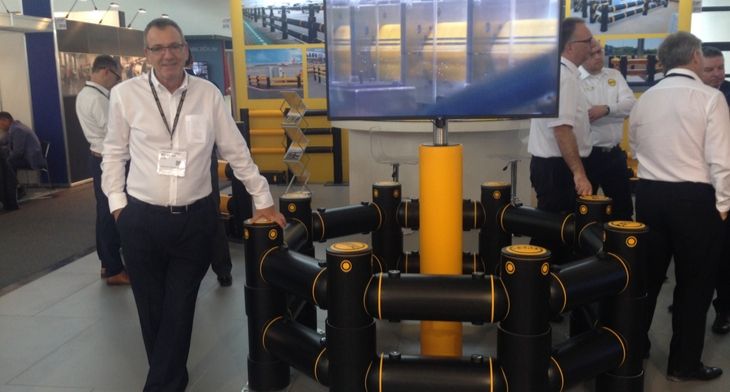Chloë Greenbank took time out with A-Safe’s UK managing director, Neil Clifford, during this year’s inter airport Europe in Munich to find out why the Atlas barrier helps ensure safe, efficient operations.
A-Safe was founded by David Smith back in 1984 and is a specialist manufacturer and supplier of high-performance safety barriers and associated products. In 2001 the company launched the world’s first industrial-strength safety barrier and has been at the forefront of airport safety for more than 15 years. As the company continues to innovate, it is constantly looking for new ways to push the boundaries of safety technology.
Why did you enter the airport sector?
The core markets for us originally were warehousing, distribution and manufacturing industries – essentially anywhere we want to protect structures from vehicles or segregate vehicles from pedestrians. However, around 10 years ago the airport sector became a significant sector for us and our Atlas range is designed specifically for the airport market. The Atlas is our strongest barrier and is capable of withstanding impacts from fully laden baggage tugs and dollies. It was originally designed for baggage hall applications for Heathrow Terminal 5, but has now been adopted by airports throughout the UK, including London Stansted and Manchester, as well as other hubs around the world. Although there are A-Safe subsidiary companies around Europe all manufacturing is done in the UK.
What does A-Safe offer in the airport sector?
Around 90% of what we supply into the airport market is from the Atlas range. Airports are busy, heavy-duty environments with numerous ground support vehicles in operation, such as tugs, dollies and fuel trucks. The risk of collisions is high. Around 90% of what we supply into the airport sector is from our Atlas range. We also cover pedestrian segregation with our three-rail barrier. But we will tailor our offer to each airport’s needs. We like to get on-site, see the application, look at the types of vehicles in use, assess their weights, speed and types of impact. From that we can build a risk assessment to establish the optimum types of barriers required for each respective environment.
What is different about your products?
Our barriers are made from extruded polypropylene. The extrusion process (where we re-align the molecular structure from random to linear formation) is carried out in house for global supply. The main technology and know-how is in the material composition. It’s a multi-layer pipe system that we extrude and each of the layers has a slightly different material composition of polyolefins and rubber additives. It’s that combination of material know-how and the extrusion process that provides the material with its energy absorption properties. So, it deflects on impact, absorbs the energy and then goes back to its original position.
What makes you stand out from your competitors?
Our solutions are scalable and can be tailored to the individual airport’s needs. We’ve worked with all sizes [of] airports from Jersey Airport in the UK to Singapore’s Changi Airport. The big challenge we face initially when approaching a new customer is turning their mindset away from steel, as a traditional barrier material. When comparing installation costs, it’s also a more expensive option than steel, but when you look at the lifetime cost savings that can be achieved, it’s phenomenal. Gatwick was one of our first big baggage hall projects. They were spending tens of thousands of pounds on the repair and replacement of their steel barriers. We fitted their two baggage halls with A-Safe barriers about 10 years ago and I can count on one hand the spares that we’ve supplied in that period of time. So, they were getting payback in 12-18 months.
What’s in the pipeline?
The main thing is there is more competition – that’s indicative of the success we’ve had as a company. But we’re constantly trying to stay one step ahead of the game and looking at new technologies within the barrier system. We’re certainly not standing still and we’re putting massive investment into our R&D departments. We’re also making multi-million pound investments in new machinery and we’re expanding the factory as well at Elland in Halifax, UK.



